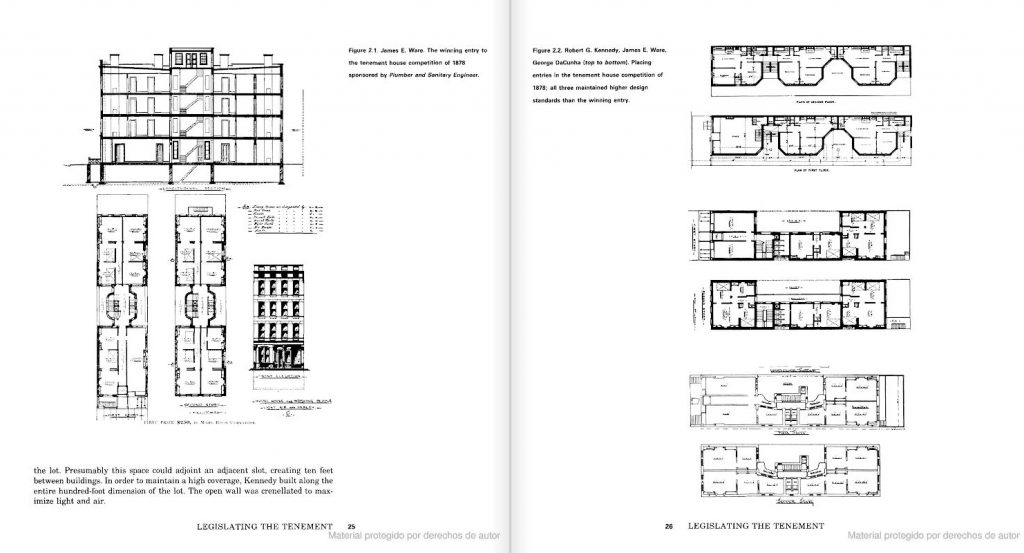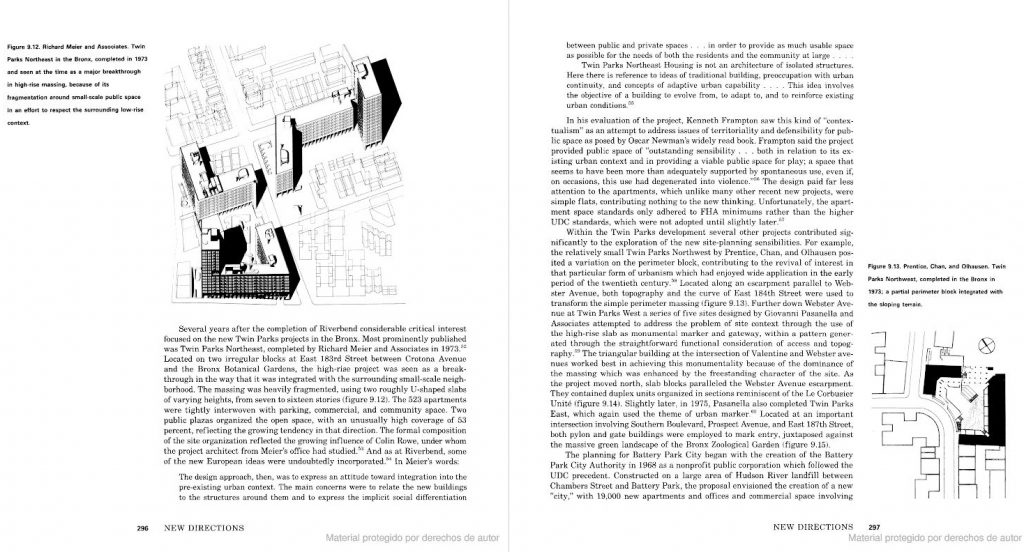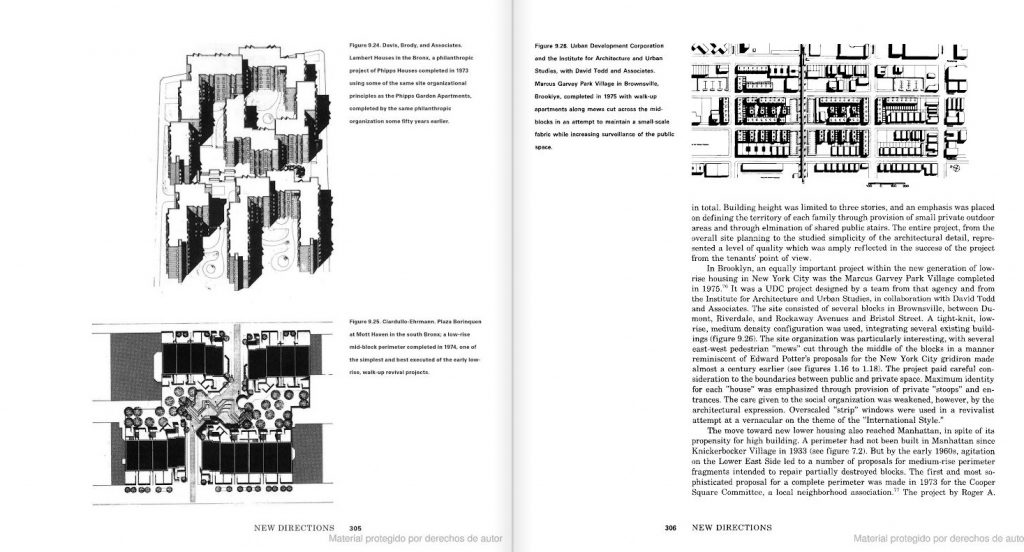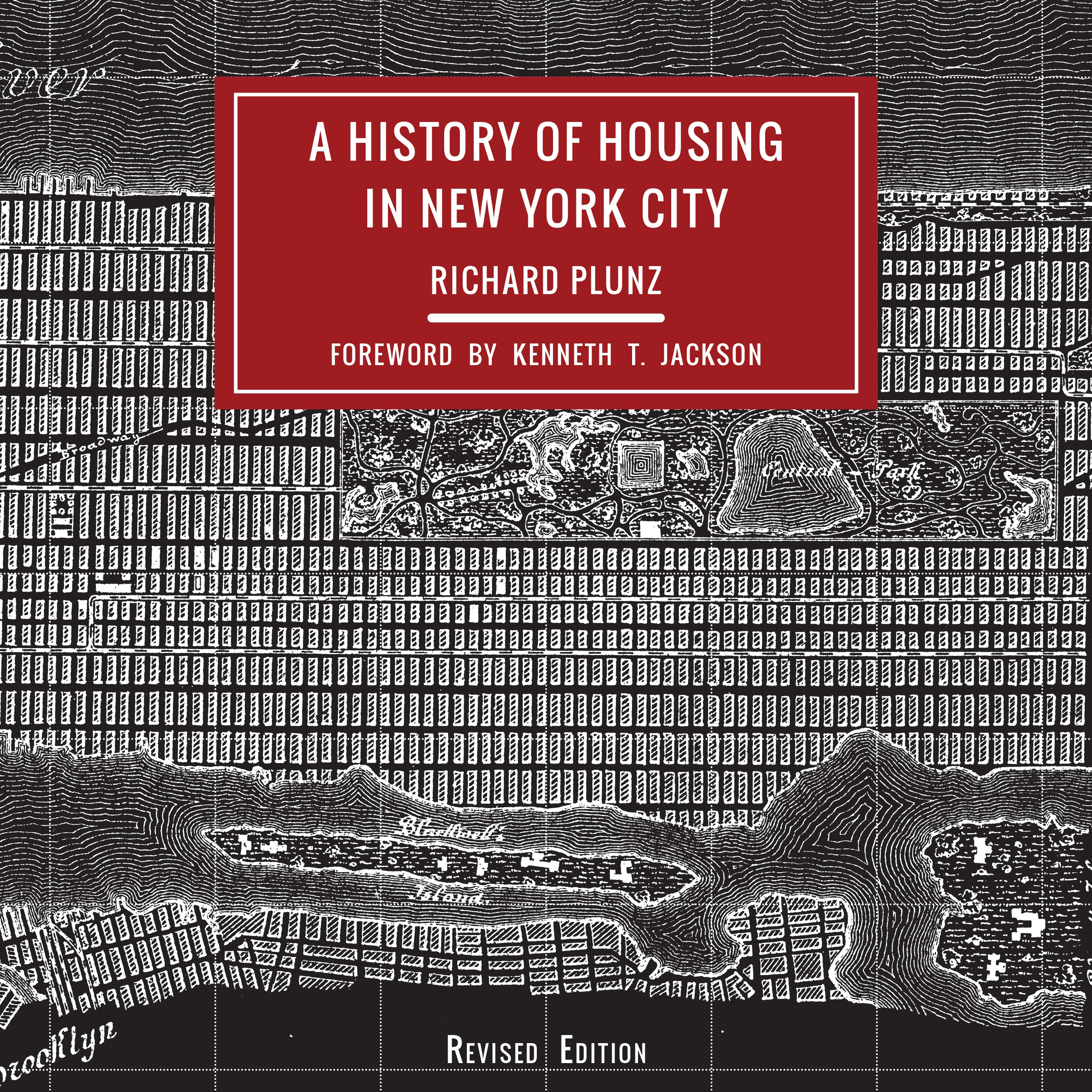***
Title: A History of Housing in New York City. Revised edition
Author: Richard Plunz
Publisher: Columbia University Press. 2016. ISBN: 9780231178358
Language: English
512 pages
***
The Brownstone houses in Brooklyn, the old Tenements in the Lower East Side, the high-end residential apartments in the Upper East Side, the continuous urban fabric int he Greenwich Village or the residential buildings or condos. Shortly after arriving in New York, I started to question myself about the collective housing in the city, its density, quality of the spaces, gentrification, or social inequality. Topics that, from an economic, urban and sociological perspective shape its domesticity. New York is an extreme city without any comparison in the United States, Europe, or Asia. Its strong capitalist economy, its globalization, and multiracial society collide with a specific geographical and urban form that creates a tension between the collective and individual space.
Las casas Brownstone en Brooklyn, los antiguos Tenements del Lower East Side, los apartamentos residenciales exclusivos en el Upper East Side, el tejido residencial continuo en el Greenwich Village o los nuevos edificios residenciales o condominios. Al poco de comenzar a vivir en Nueva York, uno comienzo a hacerse preguntas en torno a la vivienda colectiva en la ciudad, a su densidad, calidad de los espacios, gentrificación o desigualdad social. Temas que desde un punto de vista urbano, económico y sociológico conforman su domesticidad. Nueva York es una ciudad extrema, sin ningún tipo de paralelismo en Estados Unidos, Europa o Asia. Su fuerte economía capitalista, su globalización y sociedad multirracial se confrontan con una forma geográfica y urbana y tensan al máximo la relación entre el espacio colectivo y el individual.

“By 1880, only three decades later, the cityscape had already changed to a degree unimagined at the beginning of the century. The new urban order and the speed with which it developed led to self-consciousness and self-doubt as to what the city would become: a collective crisis of identity. It is interesting to examine which changes people anticipated and which they did not. Many issues that were raised in the twentieth century are hardly resolved and perhaps have only been intensified.”
“En 1880, solo tres décadas después, el paisaje urbano ya había cambiado hasta un grado inimaginable a principios de siglo. El nuevo orden urbano y la velocidad con que se desarrolló condujeron a la autoconciencia y la duda sobre lo que la ciudad terminaría convirtiéndose: una crisis colectiva de identidad. Es interesante examinar qué cambios anticiparon las personas que iban a pasar y cuáles no. Muchos de los problemas que surgieron en el siglo XX apenas se han resuelto y tal vez solo se han intensificado “.
A History of Housing in New York City Revised edition. 2016 Richard Plunz, published by Columbia University Press. page XXXV.
New York, with very few exceptions, does not have public space understood as an open and free place of the relationship between individuals as opposed to the private one. But then, how is the private area? The book A History of Housing in New York City written by Richard Plunz and with a foreword by Kenneth T. Jackson makes a comprehensive study of the evolution of collective housing in New York from its beginnings in the nineteenth century to the present. Richard Plunz analyzes each historical period from a political, urban, and social perspective, and uses several relevant housing examples that explain in detail the evolution of housing. The book is an ambitious and exhaustive journey through time and concerns about the domestic space of these last two centuries, and confronting them through the understanding of housing as a commodity and speculative product to commercial exchange. For instance, the book rigorously analyzes and compares the necessity of natural sunlight and healthiness with the percentage of building coverage of the plot. Plunz also mentions the connection between housing typologies and crime in subsidized public housing.
En Nueva York, salvo excepciones puntuales, no existe el espacio público entendido como un lugar abierto y gratuito de relación entre individuos en contraposición al privado. Pero entonces, ¿cómo es el espacio privado? El libro A History of Housing in New York City escrito por Richard Plunz y con introducción de Kenneth T. Jackson realiza un estudio exhaustivo sobre la evolución de la vivienda colectiva en Nueva York desde sus inicios en el siglo XIX hasta la actualidad. Richard Plunz analiza cada periodo histórico desde una perspectiva política, urbana y social, y utiliza varios proyectos habitacionales relevantes que explican detalladamente la evolución de la vivienda. El libro es un ambicioso y exhaustivo viaje en el tiempo y en las preocupaciones en torno al espacio doméstico de estos dos últimos siglos, enfrentándolos al entendimiento de la vivienda como un producto especulativo destinado al intercambio comercial y enriquecimiento. De este modo, se comparan de manera rigurosa y analítica temas como la necesidad de iluminación natural y salubridad en contraposición con la edificabilidad del terreno, o la relación entre tipologías habitacionales y crimen en vivienda pública.

The first chapters of the book explain the born of the Tenements (named in New York to collective housing for the most deprived social classes without any type of natural lighting or healthiness) in the Lower East Side and its expansion through the entire city after the Commissioners’ Plan of 1811 that would define the urban form of Manhattan. These chapters explore and appraise the continuous effort of several anonymous architects that aimed to harden the municipal regulation and finding housing alternatives to this typology that could improve the lives of the tenants. The central chapters of the book explore the change of paradigm occurred by technologic improvements at the beginning of the XX Century and the new urban models proposed by the modern movement. They were adapted to New York and its urban form through the garden city and the creation of the Projects (affordable housing, usually with a tower shape, that are run by government authority)
Los primeros capítulos del libro explican el nacimiento de los Tenements (referidos en Nueva York a viviendas colectivas para las clases más desfavorecidas sin ningún tipo de iluminación natural o salubridad) en el Lower East Side y su expansión por toda la ciudad tras el Plan Urbano de de los Comisionados en 1811 que definiría la trama urbana de Manhattan. Estos capítulos abordan y ensalzan el esfuerzo continuado de varios arquitectos anónimos que trataron de endurecer la normativa urbanística y encontrar alternativas habitaciones a este tipo edificatorio que mejoraran las condiciones de vida de sus inquilinos. Los capítulos centrales del libro exploran el cambio de paradigma efectuado por los avances tecnológicos de principios del siglo XX y los nuevos modelos urbanos propuestos movimiento moderno. Su adaptación a Nueva York y su trama urbana fue a través de la ciudad jardín y el nacimiento de los Projects (vivienda social, normalmente en altura, en manos de una autoridad gubernamental local o estatal).

“A confluence of economic, technological, and sociological phenomena created new housing types, which in their various forms came under the loose rubric of the “garden apartment.” It was an advance which focused on the developing outer boroughs rather than in Manhattan, where stagnation of residential development was already in evidence.”
“Una confluencia de fenómenos económicos, tecnológicos y sociológicos creó nuevos tipos de viviendas, que en sus diversas formas quedaron bajo la rúbrica del” apartamento en el jardín “. Fue un avance que se centró en los barrios periféricos en desarrollo en lugar de en Manhattan, donde el estancamiento del desarrollo residencial ya estaba en evidencia “.
A History of Housing in New York City Revised edition. 2016 Richard Plunz, published by Columbia University Press. page 122.
From an architectural perspective, the most exciting chapters are The Garden Apartment and New Directions. In the first one, Plunz analyses the proposals that came after the hardening of the legislation about collective housing. One of the most successful examples was the ‘C’ form typology that adapted to the limit of the property and, at the same time, created a garden when several buildings were joined in the same block. Within the chapter New Directions, Plunz develops an extensive research study of one of the more progressive creative periods of collective housing in New York. Once was proved in the 1960s that the isolated residential tower was a failure within the context of New York, several architects started to overcome the rigid idea that domestic architecture was exclusively private and should have a relation with the city or the public space. They built several projects (mainly in the Bronx and East Manhattan) that enhance the city by dissolving the boundaries between the street and the private property and proposing a transition of spaces from public to semi-private. The last chapter of the book, Entropies and Atrophies, describes the previous decades of the twentieth century in New York: the dismantling of public policies in collective housing after Nixon came to power, the growth of inequality and the disconnection of architects with this problematic, more focused on luxury residential architecture, or the gentrification of southern Manhattan. Originally published in 1992, the book was republished in 2016 with an epilogue where it portrays the progress of residential architecture in the last two decades.
Desde un punto de vista puramente arquitectónico, los capítulos más interesantes son The Garden Apartment (El Apartamento Jardín) y New Directions (Nuevas Direcciones). En el primero, Plunz analiza las propuestas que surgieron tras el endurecimiento de la legislación sobre la vivienda colectiva. Uno de los casos más exitosos fue la tipología en forma de ‘C’ que se adaptaba al límite de la propiedad y al mismo tiempo creaba un jardín interior al unir varios edificios dentro de una misma manzana. Dentro del capítulo New Directions, Plunz desarrolla un extenso estudio sobre uno de los periodos más progresivos y creativos de la vivienda colectiva en Nueva York: una vez demostrado en los años 60 que la vivienda en altura aislada era un fracaso dentro del contexto de Nueva York, varios arquitectos empezaron a confrontar la idea, inflexible hasta entonces, de que la arquitectura doméstica era exclusivamente privada y no debía tener ninguna relación con la ciudad o el espacio público. Aparecieron varios proyectos (principalmente en el Bronx y el este de Manhattan) que construían ciudad diluyendo el límite entre la calle y la propiedad privada y proponiendo una transición de espacios públicos a semi-privados. El último capítulo del libro, Entropies and Atrophies (Entropías y atrofias) describe las últimas décadas del siglo XX en Nueva York: el desmantelamiento de las políticas públicas en vivienda colectiva tras la llegada de Nixon al poder, el crecimiento de la desigualdad y la desconexión de los arquitectos con esta problemática, más centrados en la arquitectura residencial de lujo, o la gentrificación del sur de Manhattan. Publicado originalmente en 1992, el libro se reedito en 2016 con un epílogo en donde retrata el avance de la arquitectura residencial en las últimas dos décadas.

A History of Housing in New City is an essential book for those practitioners that work in New York. The book that has a tremendous amount of historical information, references to regulations, and extensive architecture documentation is the most comprehensive publication to this date about collective housing in this city. Because of its extension and complexity, the book can be challenging to follow at some moments, and it requires to be read with different intensity depending on the necessity. Perhaps, the only part of the book that is less developed is the epilogue. The author narrates the current situation of housing with less depth, and he sidesteps some contemporary problems.
A History of Housing in New York City es un libro necesario para aquellos arquitectos que ejercen en Nueva York. Acompañado de fechas, datos, referencias a leyes y una extensa documentación arquitectónica es, sin ninguna duda, la publicación más exhaustiva hasta la fecha sobre la vivienda colectiva en esta ciudad. Debido a su extensión y complejidad, el libro puede resultar difícil de seguir en ciertos momentos por lo que requiere ser leído a distintas velocidades en función de la necesidad. Quizás, la única parte del libro desarrollada con menor complejidad es el epílogo ya que el autor narra la problemática actual de la vivienda de un modo menos incisivo, obviando ciertos temas.

“While the juxtaposition of extreme wealth and poverty had always been a conspicuous aspect of the culture of housing in New York City, the decades at the close of the twentieth century produced a unique physical commentary on this condition. For the first time, fundamental changes in the economy of the city produced a reduction in the housing stock, a worsening of the domestic living standards for the poor, and a widening gap between rich and poor in which old patterns of upward social mobility appeared to have stagnated.”
“Si bien es cierto que la yuxtaposición de riqueza extrema y pobreza siempre ha sido uno de los aspectos más visibles de la cultura de la vivienda en la ciudad de Nueva York, las últimas décadas del siglo veinte aumentaron esta condición. Por primera vez, los cambios básicos en la economía de la ciudad produjeron una reducción en el stock de viviendas, un empeoramiento de los niveles de vida domésticos para los pobres y una brecha social cada vez mayor entre ricos y pobres, en la que los viejos patrones de ascenso social se han estacando.”
A History of Housing in New York City Revised edition. 2016 Richard Plunz, published by Columbia University Press. page 322.
As a final thought, the book provokes alarming feeling: after two centuries attempting to improve the collective housing, it seems that New York has gone back to square one. Beyond solving the healthiness problems, it appears that all the progressive efforts, first in the 1920s and then in the 1960s, to create a better domestic space have not been enough. The city continues having a social, and it seems architects have lost interest. Nonetheless, A History of Housing in New City offers built alternatives to the models that are kept in the collective imaginary of the architects. As the book shows, middle and low-income classes must always be the leading research field for architectural practitioners to achieve a better cohabitation within an urban frame.
Como reflexión final el libro deja una sensación inquietante: tras dos siglos tratando de mejorar la vivienda colectiva, parece que Nueva York está volviendo al punto de partida. Más allá de solucionar los problemas de salubridad, parece que todos los esfuerzos progresistas, primero en los años veinte y más tarde en la década de 1960, por crear un espacio doméstico de calidad han sido insuficientes. La ciudad continúa siendo socialmente igual de desequilibrada como a finales del XIX y parece que los arquitectos han dado la batalla por perdida. No obstante, A History of Housing in New York City ofrece alternativas construidas a los modelos que se mantienen en el imaginario colectivo de los arquitectos. Como demuestra este libro, la vivienda para clases medias y bajas debe ser siempre el campo de investigación principal de la práctica arquitectónica para conseguir una mayor convivencia entre individuos dentro de un marco urbano.
